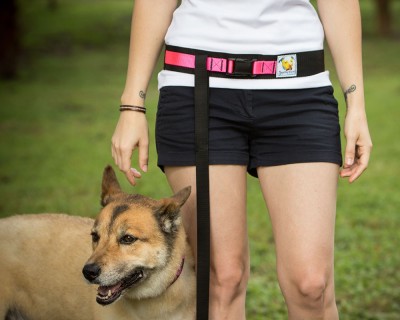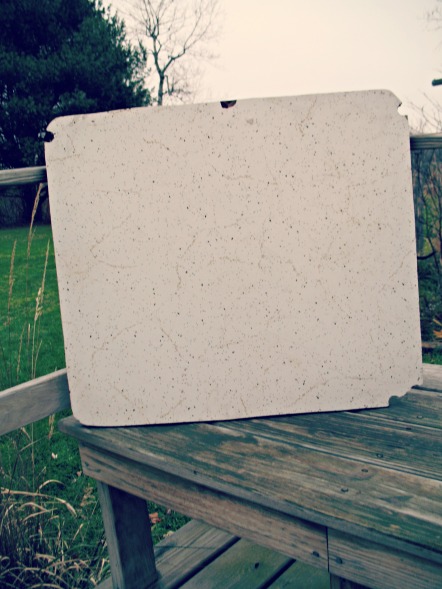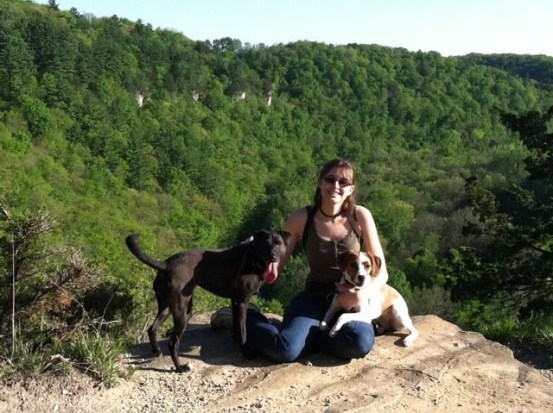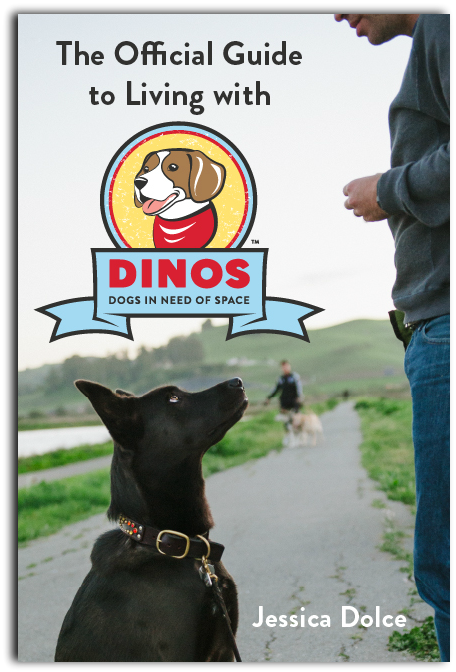We do it every day (or at least we’re told we should be doing it every day), but do you ever stop to think about why we walk our dogs and if it’s really benefiting them?
As a professional dog walker, I can come up with tons of good reasons to take dogs for daily walks: for exercise, to go to the bathroom, to train them and teach them leash manners, to help them socialize with other dogs and people, to expose them to new things and environments, and to spend time enjoying their company.
But the truth is, for some dogs, going on walks isn’t all it’s cracked up to be. And if that’s the case, there are lots of ways to meet the varying needs of dogs beyond the typical daily walk.
Last year at the BAD RAP Rescue Jam, I had the chance to meet Letti de Little, owner of former Vick dog, Uba. Word on the street was that her little survivor was a card carrying member of Team DINOS and wasn’t a big fan of going for walks in public.
I talked with Letti about how she fully supports Uba’s needs, without relying on a daily dog walking routine. These two are a great example of how thinking outside of the box (or walk in this case) might benefit some dogs. I think y’all will dig our conversation!
Jessica: Can you tell everyone a little bit about yourself and Uba?
Letti: Uba is one of the dogs rescued from football player Michael Vick’s dog fighting operation in 2007. He was quite young when seized, probably under six months old, and he was held in custody in a small kennel with no enrichment from April until October 2007. He did not have bedding, toys, walks or any of the other stimulation that is so important in a young dog’s development.
It was assumed while he was in custody that he and all the other dogs rescued in the Vick case would be euthanized once the case was over, as was the general rule for dogs rescued from fighting operations at the time.
Luckily, the Federal investigators, the prosecutors, and the judge in the case were willing to explore the option of saving the dogs and Uba and his extended family were given a chance at real life.

When he arrived in California he showed everyone that he was a huge character. He had a very vertical approach to the world and would jump around rather than walk or run. After a wind storm he decided to collect the fallen sticks from the yard and fill his crate up with branches and twigs. Later he learned to unlatch crates and he would let himself out and then break in to other dog’s crates so he could borrow their toys.
Balancing out all this silly, ridiculous behavior were his worries about the big world. At home he was a party boy, but out in the world he was very anxious and would ‘pancake’ – shut down, freeze and be unable to recover.
I had been a BAD RAP volunteer for about a year and a half when the Vick dogs were evaluated for placement and I offered to foster one of the dogs. As soon as I met Uba I knew I’d keep him and I’m so glad I did.
I’ve learned so much from my funny, energetic, intelligent, sweet and worried little dude. I’ve fostered at least ten dogs and he is the highest energy dog I have ever lived with. It’s not always easy to meet his needs while keeping up with my sometimes demanding career, but we’ve muddled through it and I think we have done OK.
What were those early dog walks like for him? And why did you choose to stop taking him for traditional daily walks?
Uba made it clear from the start that he needed a lot of exercise. As a city dwelling dog owner my answer to that was lots of long walks.
Uba really didn’t have much of an idea about leash walking, let alone cars, buses, pedestrians and all the other sites and sounds of city living. He accepted some things, like garbage trucks, without question. Other city events, like groups of pedestrians, made him collapse in fear.
We would go on long walks and he would enjoy the parts of the walks in quiet and natural areas, but would shut down and ‘pancake’ in busy areas. Living in San Francisco, most parks are full of off leash dogs, and, although he’s not particularly dog reactive, it was difficult to find places to walk him where he was comfortable and we wouldn’t be accosted by MDIFs.
[Note from Jessica: MDIF stands for people who shout “My Dog is Friendly!” and let their dogs approach yours without permission. How rude! You can read more about them here.]
I used to have a roommate who is a psychologist working with combat veterans and she noted that his physical reaction on walks was very similar to her patients suffering from PTSD. Uba scans for trouble, shakes, and can’t focus on anything other than his fear. Once Uba is triggered into his scary place there is no talking him out of it. He won’t take treats or toys; even super high value treats like steak don’t distract him from his fear.

I moved to Oakland after about three years with Uba, and my neighborhood is still pretty urban, although I have a much bigger back yard than in San Francisco. He had a hard time adjusting to the neighborhood and did not enjoy his walks at all.
After much debate and discussion with BAD RAP’s Tim Racer, I decided that we should re-set and not go for neighborhood walks for a month. We still went on weekend walks in places he enjoyed, where there is nature and limited MDIFs, but I didn’t make him go into the neighborhood at all.
In that month I found that he became more relaxed and our relationship improved when I wasn’t making him face his worst fears every day.
Instead of dog walks, how do you provide Uba with exercise, enrichment, socialization, and time outside?
Since Uba was so energetic as a youngster I started using a dog treadmill for exercise soon after he came to me. The first time I put him on the Grand Carpet Mill he was hooked. I didn’t have to teach him what to do, he just hopped on, let me hook up his harness and he ran as fast as he could with a huge smile on his face.
I also use a flirt pole and a spring pole. The flirt pole is nice as it can also give an opportunity for working on impulse control (not Uba’s strong suit) and other basic training. I have a spring pole set up near my treadmill and some days Uba runs to that instead of the treadmill when its time to work out. The tugging lets him use different muscles and makes him just as tired. He gets really excited when I say “treadmill” or “spring pole”, just like some dogs get excited when you pick up their leash.
Uba has always loved training and learning, so I have tried a few different activities with him. Vick dog Audie’s owner, Linda Chwistek, introduced me to K9 Nose Work as it was just developing as a sport and Uba loves it.
Nose work has built Uba’s confidence like nothing else. Before nose work, new environments and new people were very difficult and Uba would shake and pancake to avoid the new experience. Now, Uba can walk in to a new place and he wants to see if he can find a target odor, even if that’s not at all why we’re there. We take nose work classes at least once a week and he loves seeing all his friends as much as he loves searching.

For socialization I have almost constantly fostered well-matched playmates for Uba and many of them have also been rescued from dog fighting busts. We stay in touch with former foster dogs and other friends he’s made along the way and meet in his comfortable spaces for walks and have play dates at home. Uba sometimes accompanies me to the BAD RAP Pit Ed training classes I teach to “supervise” and see his human friends (including his number one hero, Tim).
There’s a lot of pressure on dog owners to walk their dogs every day. Do you have any advice for dog owners who may be feeling like these walks aren’t benefiting their dogs?
We all need down time. I don’t feel like going out and facing the world every single day, and neither do some dogs.
I think we should be focusing on “all dogs need regular exercise” instead of “dogs should be walked daily”.
Yes! That’s really well said Letti!
Exercise is not opening the back door and letting your dog wander the yard, though. If you’re not walking your dog you need to consider how to keep yourself and your dog engaged in a healthy and happy relationship. If she loves fetch, that’s wonderful, but make sure you play other games too. Take that hour you would be walking and spend it with your dog – not on the phone or computer – but actively engaging with your dog. Learn a new trick or find a new game to play.
Remember that mental stimulation can be just as tiring as physical exercise, so find ways to combine both and see how pleased your dog is. Training classes of any kind are great ways to get your dog exercise, mental stimulation and socialization opportunities while working on useful and fun skills.
On the flip side, there are lots of dogs that could really benefit from more walks! But because they’re reactive or are lacking in basic manners, their owners avoid walking them.
You work with families like this in your training classes. Is there a difference between what they’re experiencing and what you experienced with Uba? Any advice for these folks to help them feel more comfortable walking their dogs?
I should be clear that Uba is not particularly dog reactive. He is a DINOS because I want to protect him from bad experiences that could make his phobias even worse or push him to be reactive. He collapses in fear rather than screaming at the end of his leash.
If your dog lacks manners, get to a training class! If you are too far from training classes or can’t afford them, You Tube has some great resources and examples of how to work on leash skills. Or hire a trainer for one on one help. I truly believe that any dog can be well mannered in public if their owner puts in the time and effort and effectively manages the situations the dog is in.
If the dog simply needs to get out for exercise right now, do some research and find places that are safe to walk. Be willing to take a short drive to your walking places if needed. Think outside the box about where to walk and try different routes. Just walking on a different side of the street can dramatically change the walk for your dog. Your neighborhood may be packed with challenges for your dog, but what about other areas nearby? What about the outside perimeter of a public park, golf course or a cemetery? Is there a downtown business district that’s super quiet on the weekend?
I advise people to stop worrying about what other people think. You are your dog’s only advocate. Speak up and protect your dog from MDIFs and mean people. If you encounter people who criticize you for something you’re doing or not doing, shrug it off. Don’t worry if your dog doesn’t conform to some general theory of what dogs should be and help your dog be the best dog she can be. So what if that means walks at midnight or running on a treadmill?
I also highly recommend nose work classes as therapy for the dogs and as a place to find solidarity with other owners of DINOS.
How’s Uba doing today?
Uba is still not a big fan of neighborhood walks. He will go with me once in a while and enjoy himself, but I don’t force the issue. More often we’ll hop in the car and drive to a cemetery that allows leashed dogs or one of the parks where leashes are required.
This means that in the winter when it’s dark after work he really only gets walked on weekends. During the week we go to nose work class, run on the treadmill and play at home.
He is getting a little calmer now that he’s eight, but he’s still more energetic than most dogs half his age, and I think he gets a good amount of exercise, is appropriately mentally challenged and gets out to see his friends regularly.

We still have little moments of victory over his worry – just this morning we went on a very pleasant neighborhood walk. He sniffed things, peed on a million things and worked through his “oh shit!!” moments. I think he enjoyed it.
Earlier on, I came to realize that in my desire to have a walking companion I was ignoring Uba’s needs. I have learned to respect what my dog is telling me and now I really accept Uba for who he is and not who I’d like him to be. We are both happier and more relaxed and our relationship is much more fun for both of us.
Great advice Letti and thank you for sharing Uba with us!





































